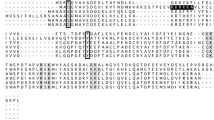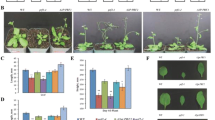Abstract
Endoreplication is a type of cell cycle where genome replication occurs without mitosis. An increase of ploidy level by endoreplication is often associated with cell enlargement and an enhanced plant growth. Here we report Arabidopsis thaliana subclass I ACTIN DEPOLYMERIZING FACTORs (ADFs) and vegetative ACTIN2/8 as novel regulators of endoreplication. A. thaliana has 11 ADF members that are divided into 4 subclasses. Subclass I consists of four members, ADF1, -2, -3, and -4, all of which constitutively express in various tissues. We found that both adf4 knockout mutant and transgenic plants in which expressions of all of four subclass I ADFs are suppressed (ADF1-4Ri) showed an increased leaf area of mature first leaves, which was associated with a significant increase of epidermal pavement cell area. Ploidy analysis revealed that the ploidy level was significantly increased in mature leaves of ADF1-4Ri. The increased ploidy was also observed in roots of adf4 and ADF1-4Ri, as well as in dark-grown hypocotyls of adf4. Furthermore, double mutants of vegetative ACT2 and ACT8 (act2/8) exhibited an increase of leaf area and ploidy level in mature leaves. Therefore, actin-relating pathway could regulate endoreplication. The possible mechanisms that actin and ADFs regulate endoreplication are discussed.





Similar content being viewed by others
References
Adachi S, Minamisawa K, Okushima Y, Inagaki S, Yoshiyama K, Kondou Y, Kaminuma E, Kawashima M, Toyoda M, Toyoda T, Matsui M, Kurihara D, Matsunaga S, Umeda M (2011) Programmed induction of endoreduplication by DNA double-strand breaks in Arabidopsis. Proc Natl Acad Sci USA 108:10004–10009
An YQ, McDowell JM, Huang S, McKinney EC, Chambliss S, Meagher RB (1996) Strong, constitutive expression of the Arabidopsis ACT2/ACT8 actin subclass in vegetative tissues. Plant J 10:107–121
Baarlink C, Plessner M, Sherrard A, Morita K, Misu S, Virant D, Kleinschnitz E-M, Harniman R, Alibhai D, Baumeister S, Miyamoto K, Endesfelder U, Kaidi A, Grosse R (2017) A transient pool of nuclear F-actin at mitotic exit controls chromatin organization. Nat Cell Biol 19:1389–1399
Boudolf V, Kobe V, Beemster GTS, Magyar Z, Torres Acosta JA, Maes S, Van Der Schueren E, Inzé D, De Veylder L (2004) The plant-specific cyclin-dependent kinase CDKB1;1 and transcription factor E2Fa-DPa control the balance of mitotically dividing and endoreduplicating cells in Arabidopsis. Plant Cell 16:2683–2692
Burgos-Rivera B, Ruzicka DR, Deal RB, McKinney EC, King-Reid L, Meagher RB (2008) ACTIN DEPOLYMERIZING FACTOR9 controls development and gene expression in Arabidopsis. Plant Mol Biol 68:619–632
Caridi CP, D’Agostino C, Ryu T, Zapotoczny G, Delabaere L, Li X, Khodaverdian VY, Amaral N, Lin E, Rau AR, Chiolo I (2018) Nuclear F-actin and myosins drive relocalization of heterochromatic breaks. Nature 559:54–60
Clément M, Ketelaar T, Rodiuc N, Banora MY, Smertenko A, Engler G, Abad P, Hussey PJ, de Almeida EJ (2009) Actin-Depolymerizing Factor2-mediated actin dynamics are essential for root-knot nematode infection of Arabidopsis. Plant Cell 21:2963–2979
Cookson SJ, Radziejwoski A, Granier C (2006) Cell and leaf size plasticity in Arabidopsis: what is the role of endoreduplication? Plant Cell Environ 29:1273–1283
Dong CH, Xia GX, Hong Y, Ramachandran S, Kost B, Chua NH (2001) ADF proteins are involved in the control of flowering and regulate F-actin organization, cell expansion, and organ growth in Arabidopsis. Plant Cell 13:1333–1346
Duan S, Hu L, Dong B, Jin H-L, Wang H-B (2020) Signaling from plastid genome stability modulates endoreplication and cell cycle during plant development. Cell Rep 32:108019. https://doi.org/10.1016/j.celrep.2020.108019
Gilliland LU, Pawloski LC, Kandasamy MK, Meagher RB (2003) Arabidopsis actin gene ACT7 plays an essential role in germination and root growth. Plant J 33:319–328
Haga N, Kobayashi K, Suzuki T, Maeo K, Kubo M, Ohtani M, Mitsuda N, Demura T, Nakamura K, Jurgens F, Ito M (2011) Mutations in MYB3R1 and MYB3R4 cause pleiotropic developmental defects and preferential down-regulation of multiple G2/M-specific genes in Arabidopsis. Plant Physiol 157:706–717
Henty JL, Bledsoe SW, Khurana P, Meagher RB, Day B, Blanchoin L, Staiger CJ (2011) Arabidopsis Actin Depolymerizing Factor4 modulates the stochastic dynamic behavior of actin filaments in the cortical array of epidermal cells. Plant Cell 23:3711–3726
Henty-Ridilla JL, Li J, Blanchoin L, Staiger CJ (2013) Actin dynamics in the cortical array of plant cells. Curr Opin Plant Biol 16:678–687
Herrera-Vásquez A, Salinas P, Holuigue L (2015) Salicylic acid and reactive oxygen species interplay in the transcriptional control of defense genes expression. Front Plant Sci 6:171. https://doi.org/10.3389/fpls.2015.00171
Heyman J, Can den Daele H, De Wit K, Boudolf V, Berckmans B, Verkest A, Alvim Kamei CL, De Jaeger G, Koncz C, De Veylder L (2011) Arabidopsis ULTRAVIOLET-B-INSENSITIVE4 maintains cell division activity by temporal inhibition of the anaphase-promoting complex/cyclosome. Plant Cell 23:4394–4410
Hyrskyluoto A, Vartiainen MK (2020) Regulation of nuclear actin dynamics in development and disease. Curr Opin Cell Biol 64:18–24
Imai KK, Ohashi Y, Tsute T, Yoshizumi T, Matsui M, Oka A, Aoyama T (2006) The A-type cyclin CYCA2;3 is a key regulator of ploidy levels in Arabidopsis endoreduplication. Plant Cell 18:382–396
Inada N (2017) Plant actin depolymerizing factor: actin microfilament disassembly and more. J Plant Res 130:227–238
Inada N, Higaki T, Hasezawa S (2016) Nuclear function of subclass I actin-depolymerizing factor contributes to susceptibility in Arabidopsis to an adapted powdery mildew fungus. Plant Physiol 170:1420–1434
Ishida T, Fujiwara S, Miura K, Stacey N, Yoshimura M, Schneider K, Adachi S, Minamisawa K, Umeda M, Sugimoto K (2009) SUMO E3 ligase HIGH PLOIDY2 regulates endocycle onset and meristem maintenance in Arabidopsis. Plant Cell 21:2284–2297
Ishida T, Adachi S, Yoshimura M, Shimizu K, Umeda M, Sugimoto K (2010) Auxin modulates the transition from the mitotic cycle to the endocycle in Arabidopsis. Development 137:63–71
Kandasamy MK, McKinney EC, Meagher RB (2009) A single vegetative actin isovariant overexpressed under the control of multiple regulatory sequences is sufficient for normal Arabidopsis development. Plant Cell 21:701–718
Kandasamy MK, McKinney EC, Meagher RB (2010) Differential sublocalization of actin variants within the nucleus. Cytoskelet 67:729–743
Lang L, Schnittger A (2020) Endoreplication—a means to an end in cell growth and stress response. Curr Opin Plant Biol 54:85–92
McDowell JM, An YQ, Huang S, McKinney EC, Meagher RB (1996a) The Arabidopsis ACT7 actin gene is expressed in rapidly developing tissues and responds to several external stimuli. Plant Physiol 111:699–711
McDowell JM, Huang S, McKinney EC, An YQ, Meagher RB (1996b) Structure and evolution of the actin gene family in Arabidopsis thaliana. Genetics 142:587–602
Mondal HA, Louis J, Archer L, Patel M, Nalam VJ, Sarowar S, Sivapalan V, Root DD, Shah J (2018) Arabidopsis ACTIN-DEPOLYMERIZING FACTOR3 is required for controlling aphid feeding from the phloem. Plant Physiol 176:879–890
Nobusawa T, Okushima Y, Nagata N, Kojima M, Sakakibara H, Umeda M (2013) Synthesis of very-long-chain fatty acids in the epidermis controls plant organ growth by restricting cell proliferation. PLOS Biol 11:e1001531. https://doi.org/10.1371/journal.pbio.1001531
Pasternak T, Groot EP, Kazatsev FV, Teale W, Omelyanchuk N, Kovrizhnykh V, Palme K, Mironova VV (2019) Salicylic acid affects root meristem patterning via auxin distribution in a concentration-dependent manner. Plant Physiol 180:1725–1739
Robinson DO, Coate JE, Singh A, Hong L, Bush M, Doyle JJ, Roeder AHK (2018) Ploidy and size at multiple scales in the Arabidopsis sepal. Plant Cell 30:2308–2329
Ruzicka DR, Kandasamy MK, McKinney EC, Burgos-Rivera B, Meagher RB (2007) The ancient subclasses of Arabidopsis Actin Depolymerizing Factor genes exhibit novel and differential expression. Plant J 52:460–472
Schrannk BR, Aparicio T, Li Y, Chang W, Chait BT, Gundersen GG, Gottesman ME, Gautier J (2018) Nuclear ARP2/3 drives DNA break clustering for homology-directed repair. Nature 559:61–66
Shimotohno A, Aki SS, Takahashi N, Umeda M (2021) Regulation of the plant cell cycle in response to hormones and the environment. Annu Rev Plant Biol. https://doi.org/10.1146/annurev-arplant-080720-103739
Sugimoto-Shirasu K, Stacey NJ, Corsar J, Roberts K, McCann MC (2002) DNA topoisomerase VI is essential for endoreduplication in Arabidopsis. Curr Biol 12:1782–1786
Sugimoto-Shirasu K, Roberts GR, Stacey NJ, McCann MC, Maxwell A, Roberts K (2005) RHL1 is an essential component of the plant DNA topoisomerase VI complex and is required for ploidy-dependent cell growth. Proc Natl Acad Sci USA 102:18736–18741
Takatsuka H, Higaki T, Umeda M (2018) Actin reorganization triggers rapid cell elongation in roots. Plant Physiol 178:1130–1141
Tanaka R, Amijima M, Iwata Y, Koizumi N, Mishiba K (2016) Effect of light and auxin transport inhibitors on endoreduplication in hypocotyl and cotyledon. Plant Cell Rep 35:2539–2547
Tian M, Chaudhry F, Ruzicka DR, Meagher RB, Staiger CJ, Day B (2009) Arabidopsis actin-depolymerizing factor AtADF4 mediates defense signal transduction triggered by the Pseudomonas syringae effector AvrPphB. Plant Physiol 150:815–824
Vespa L, Vachon G, Berger F, Perazza D, Faure J-D, Herzong M (2004) The immunophilin-interacting protein AtFIP37 from Arabidopsis is essential for plant development and is involved in trichome endoreduplication. Plant Physiol 134:1283–1292
Wang D, Pajerowska-Mukhtar K, Culler AH, Dong X (2007) Salicylic acid inhibits pathogen growth in plants through repression of the auxin signaling pathway. Curr Biol 17:1784–1790
Yang S, Wang W, Marqués J, Mohan R, Saleh A, Durrant WE, Song J, Dong X (2013) Salicylic acid activates DNA damage responses to potentiate plant immunity. Mol Cell 52:602–610
Yoshizumi T, Tsumoto Y, Takiguchi T, Nagata N, Yamamoto YY, Kawashima M, Ichikawa T, Nakazawa M, Yamamoto N, Matsui M (2006) INCREASED LEVEL OF POLYPLOIDY1, a conserved repressor of CYCLINA2 transcription, controls endoreduplication in Arabidopsis. Plant Cell 18:2452–2468
Zhang P, Qian D, Luo C, Niu Y, Li T, Xiang Y, Wang X, Niu Y (2021) Arabidopsis ADF5 acts as a downstream target gene of CBFs in response to low-temperature stress. Front Cell Dev Biol 9:635533. https://doi.org/10.3389/fcell.2021.635533
Acknowledgements
We thank for Ms. Reiko Okanami and Ms. Eiko Matsumoto for technical assistance. ADF1-4Ri lines were provided by Prof. Brad Day at Michigan State University. This work was supported by Grant-in-Aid for Scientific Research (C) (KAKENHI, 16K07415 and 20K06690 for N.I.), Sumitomo foundation (180539 for N.I.), Osaka Prefecture University internal fund “RESPECT”, Women In Research Support Operation for Osaka Prefecture University, and Osumi Frontier Science Foundation (for N.I.).
Author information
Authors and Affiliations
Corresponding author
Additional information
Publisher's Note
Springer Nature remains neutral with regard to jurisdictional claims in published maps and institutional affiliations.
Supplementary Information
Below is the link to the electronic supplementary material.
Rights and permissions
About this article
Cite this article
Inada, N., Takahashi, N. & Umeda, M. Arabidopsis thaliana subclass I ACTIN DEPOLYMERIZING FACTORs and vegetative ACTIN2/8 are novel regulators of endoreplication. J Plant Res 134, 1291–1300 (2021). https://doi.org/10.1007/s10265-021-01333-0
Received:
Accepted:
Published:
Issue Date:
DOI: https://doi.org/10.1007/s10265-021-01333-0




